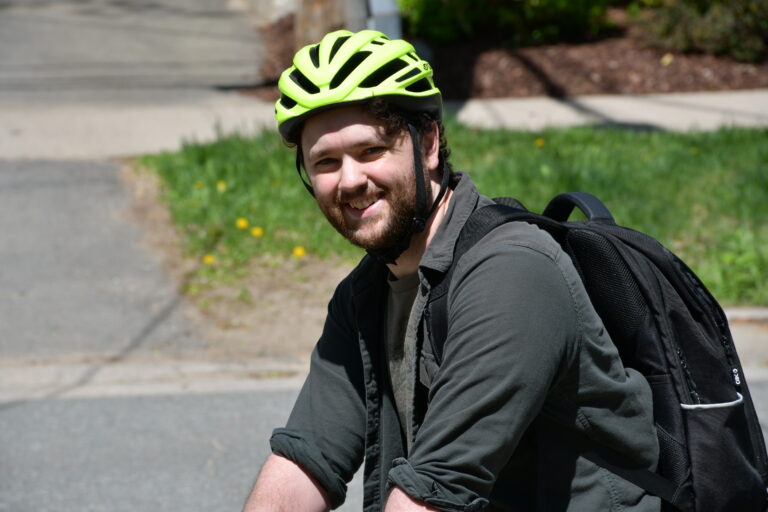Making Biking More Accessible in New Brunswick Cities
On this Bike to Work Day, I wish I could write solely about the many benefits that switching from driving to cycling has on the environment, your health, and your wallet.
It’s true, of course—cycling on your daily commute, even just a few days a week, reduces your carbon footprint (an average midsize car produces approximately 170 grammes of CO2/km), improves your cardiovascular health (cycling is a great low-impact form of exercise), and reduces your fuel consumption (especially nice right now with all-time-high prices at the pump).
What I can not tell you, unfortunately, is that New Brunswick cities are as safe for cyclists as they could be and facilitate the transition to alternative modes of transportation.
The fact of the matter is that most people do not feel comfortable biking in traffic. In the absence of separated cycling infrastructure, I can’t really blame folks for biking on the sidewalk, despite it being against some cities’ bylaws, or for not biking at all.

The No. 1 barrier to active transportation is car-centric city design and a lack of safe and accessible cycling infrastructure. Any city that recommends cycling as an alternative to driving without investing in safe and accessible infrastructure is overlooking the cause and solution– it is about transportation choices made at the municipal and provincial levels, not individual choice.
Take Fredericton, the city I live in. While it boasts an impressive multi-use trail network (a legacy of Boss Gibson rail line) that will take you across town, it lacks a connective road network to get you to the place you’re going.
The city’s on-road cycling network consists of disconnected bicycle gutters (painted lines) and shared paths with motor vehicle traffic. The implementation of a grade-separated cycle path on the city’s Northside is a positive step in the right direction, but it still lacks the connective infrastructure to make a significant impact.
To compound the problem, not one intersection (the area with the most points of conflict with other road users) in the city has cycling infrastructure integrated in it. A bike lane leading to an intersection will just end and pick up again on the other side.
Then there is the issue of winter, one of the most common refrains you’ll hear from Canadians when considering a bike lane. You know the argument—it goes, “why would we build infrastructure that we can’t use half the year?!”
If cities really want more people hanging up their keys for a bike helmet, they need to recognize that the infrastructure they build is more important than individual actions.
Adam Mahoney Tweet
The simple truth is that cycling in the winter is just as feasible as driving in the winter—cities just haven’t been clearing cycle paths and, in fact, push snow out of the way of cars and into the way of bikes.
If 12 per cent of all winter trips in Oulu, Finland are being made by bike, I think Canadians can adapt to colder conditions, too. Harsh winter cities like Montreal and Ottawa have made great strides in maintaining their cycle paths through the winter months in the past few years. They even have cycle paths that go through intersections.
Now, I’m not saying that everyone has to ride a bike. But I am saying we should make our streets safer for everyone—not just those in cars. If you’re not comfortable sending your child or a young person in your life out onto your city’s bike network, it is not safe enough—period.
If cities really want more people hanging up their keys for a bike helmet, they need to recognize that the infrastructure they build is more important than individual actions.
Recommendations to Make New Brunswick Cities Safer for Cycling:
Recommendations to Make New Brunswick Cities Safer for Cycling:
- Consider the role of pedestrians and cyclists in all new road infrastructure projects.
- Identify and fix the current gaps in the cycling infrastructure network.
- Build out the network of grade separated/separated from traffic cycling infrastructure.
- Build cycling infrastructure through intersections. Inspiration can be drawn from the Dutch model.
- Clear cycle paths as rigorously as roads are during the winter months.
- Lower traffic speeds of residential streets to make them more welcoming to non-car users.
- Build visible, accessible, and weather-protected bike parking stations in high-use areas such as downtown and on trail networks.
- Consult with bicycle users to find out what issues they have and gather their recommendations.
Share this article with your friends and family and invite them to add their voice!
